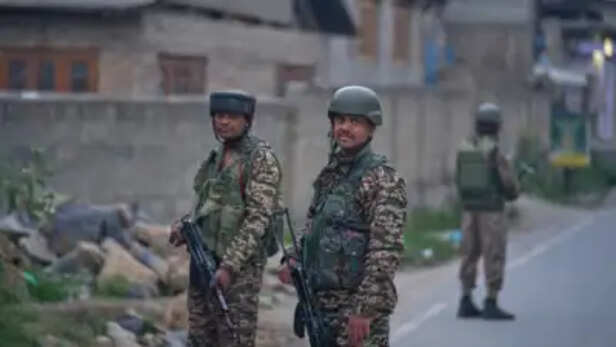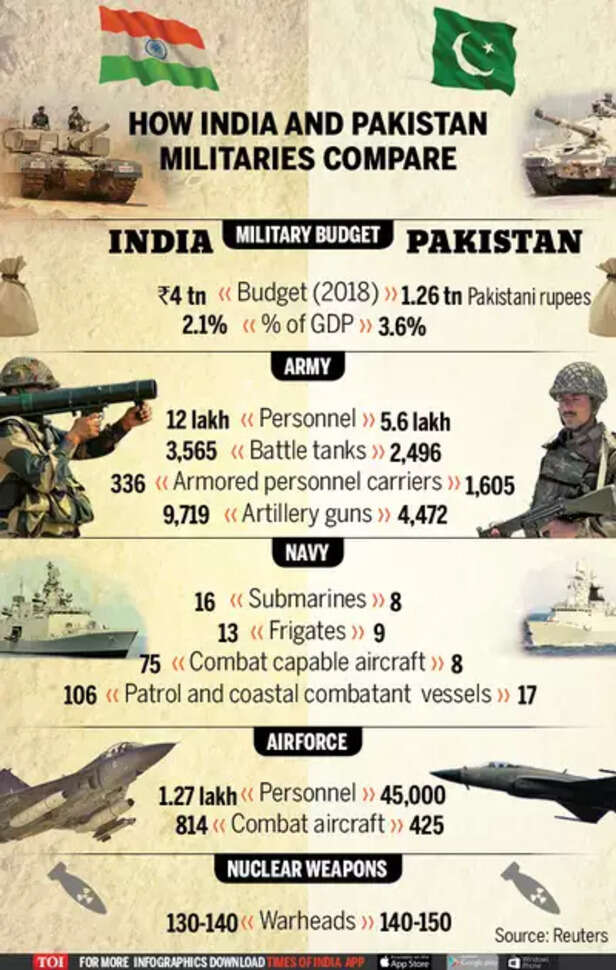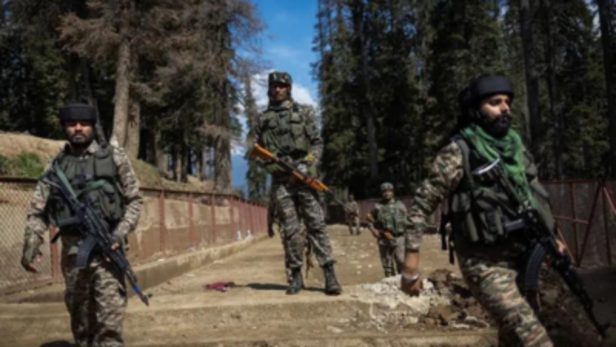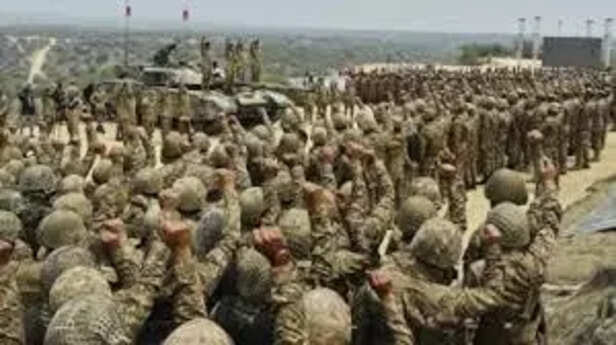Where Pakistan’s Armed Forces Stand Against India’s Military: A Human Story of Grit, Pride, and Power
Mrinal Dwivedi | Sat, 10 May 2025
Beyond the headlines and battle statistics lies a deeper, more human story — one of grit, sacrifice, and fierce national pride. This article dives into where Pakistan’s armed forces truly stand against India’s powerful military, not just through weapons and numbers, but through the spirit of the soldiers who serve. From the mountains of Kashmir to the deserts of Rajasthan, we explore the complex rivalry, shared histories, and raw emotions that fuel one of the world's most intense military standoffs. It’s not just about might — it’s about identity, endurance, and the unbreakable will to defend a nation.
Photo:
When you stand at the Wagah border at sunset, watching the boots stomp and flags rise high, you’re not just witnessing a military drill. You’re witnessing history—in all its weight, in all its tension, in all its glory. On one side, India. On the other, Pakistan. Two countries born of the same land, split by politics, stitched together by geography, and defined by a rivalry that refuses to fade.
It’s tempting to compare the militaries of India and Pakistan with cold numbers. How many tanks, how many jets, how many missiles. But that doesn’t tell you the whole story. Because behind the statistics are stories. Human ones. Soldiers who leave their mothers with trembling hugs. Pilots who kiss their children goodbye. Engineers who build defenses not for power—but for peace.
So when we ask: “Where do Pakistan’s armed forces stand against India’s?”—the real answer lies somewhere between steel and spirit.

In both countries, the military isn’t just an institution. It’s a way of life. It’s a badge of honor. For many Pakistani families, the dream isn’t to become a doctor or businessman—it’s to wear the olive green uniform, to earn the eagle badge, and to serve at the snowy frontlines of Siachen or the scorching sands of Cholistan.
In India, the military is equally revered. Children grow up watching war movies, saluting the national flag, and idolizing men like Field Marshal Sam Manekshaw or Captain Vikram Batra. For Indian soldiers, serving in the armed forces is as much about defending territory as it is about defending the values enshrined in their constitution.
Pakistan may have a smaller population—around 240 million compared to India’s 1.4 billion—but the passion that drives a Pakistani soldier is no smaller. If anything, it’s fiercer. With a smaller army, every soldier is expected to carry more weight, more responsibility. There’s an unspoken truth in the barracks: “We may be fewer, but we are not lesser.”

India’s army is massive—over a million strong. But sheer size doesn’t win battles. It’s the mindset that matters.
Pakistan’s army is roughly half the size, but the training is intense. Officers at the Pakistan Military Academy in Kakul are taught more than strategy—they’re taught sacrifice. Recruits don’t just march; they read history, learn mountain survival, and are drilled in real-world scenarios that simulate the volatile border skirmishes Pakistan faces regularly.
In India, similar dedication pulses through the Indian Military Academy in Dehradun. Their soldiers train for the high-altitude face-offs with China, for insurgency operations in Kashmir, and for humanitarian rescue missions during floods and earthquakes.
The difference lies not just in terrain, but in doctrine. India’s army is built for large-scale operations—a possible two-front war with China and Pakistan. Pakistan’s doctrine is more surgical: fast strikes, calculated movements, maximum impact with limited resources.
But ask any soldier on either side what they fight for, and they won’t say politics. They’ll say “my unit,” “my homeland,” “my brothers in arms.”
In February 2019, the world watched as jets zipped across the skies over Kashmir. The Indian Air Force struck Balakot. The Pakistan Air Force responded with swift precision. It wasn’t just a clash of technology—it was a moment that exposed the human pulse behind aerial warfare.
India’s Air Force is larger—boasting over 1,700 aircraft, including French Rafales and Russian Sukhois. Its pilots are well-trained, often collaborating with American and European counterparts in international exercises.
But the Pakistan Air Force? It’s lean, sharp, and fiercely proud. With around 800 aircraft—like the agile JF-17 Thunder and American F-16s—it focuses less on quantity and more on tactical readiness.
What makes PAF unique is its hunger. Pilots are trained to fly under pressure, to respond to crisis, and to defend airspace with grit rather than gadgets. In 2019, Pakistani pilot Hasan Siddiqui became a household name when he shot down an Indian MiG-21. In India, Wing Commander Abhinandan Varthaman became a national hero despite being captured—because he didn’t flinch in the face of danger.
That moment, as tense as it was, showed something deeper: both sides produce warriors. Not warmongers. Men who do their duty, not for fame or hatred—but because they were trained to protect.
On land, the rivalry is loud. In the air, it’s fast. But in the sea? It’s quiet. Deadly. Strategic.
India’s Navy is a blue-water force. It sails deep into oceans, far from the mainland. With aircraft carriers, nuclear submarines, and destroyers, it has a clear edge in size and ambition.
Pakistan’s Navy is smaller, more focused on coastal defense—but don’t mistake that for weakness. With diesel-electric submarines, fast-attack craft, and Chinese-backed modernization, the Pakistan Navy is like a coiled snake: quiet, but ready to strike.
Gwadar Port has added new layers of importance. It’s no longer just about defense—it’s about trade, economy, and maritime influence. Pakistan’s Navy isn’t just guarding its coasts; it’s protecting its future.
Ask a sailor from either side what life is like at sea, and they’ll tell you about isolation. About nights with no stars. About drills and alerts. But also about brotherhood. About pride. About saluting the flag as it flutters under the open sky.

Let’s be honest—what truly keeps both nations from open war is not just diplomacy. It’s deterrence.
Both India and Pakistan are nuclear powers. Both have missiles. Both have warheads. But neither wants to use them. Because behind the buttons are human lives—and both sides know that even a single miscalculation could spell disaster for millions.
India adheres to a No First Use policy. Pakistan doesn’t. And that keeps the balance fragile—but intact.
The men who manage these weapons are not robots. They’re soldiers with families. Scientists with consciences. Every drill, every test, every command center simulation is carried out with painstaking caution. Because in this chess game, one wrong move ends the match—not just for players, but for all spectators.
The battlefield has changed. No longer is it only fought with bullets and bombs. Now it’s waged with data, misinformation, and digital espionage.
India has made significant strides in space and cyber domains. With its anti-satellite weapons, intelligence satellites, and cyber command, it’s preparing for wars that don’t leave craters but crash networks.
Pakistan, meanwhile, is fast catching up. Its cyber warfare cells are becoming smarter. Its psychological operations are more agile. It focuses on hybrid warfare—blending propaganda, electronic warfare, and influence campaigns to destabilize and disrupt.
The soldiers in these wars don’t wear uniforms. They wear headphones. They code. They intercept. They protect critical systems with firewalls instead of firearms.
It’s a new kind of soldier. A silent one. But no less brave.
India is pushing hard for self-reliance. Indigenous tanks, jets, and ships are part of its “Make in India” defense initiative. It wants to not only arm itself—but also sell arms to the world.
Pakistan, while still reliant on allies like China and Turkey, is also stepping into the arena. The JF-17 jet is a symbol of that ambition. Built with China, it’s flown with pride. New warships and drones are in development. Defense exhibitions in Karachi and Islamabad are showcasing talent and technology that was once unimaginable.
But more than machines, both nations are investing in minds. Young engineers, designers, software experts—all working behind the scenes to give their countries a fighting edge without firing a bullet.
Strip away the politics. Turn off the news. Forget the speeches. What you’ll find, at the core of both militaries, is something deeply human.
In Pakistan, a 19-year-old cadet stands in uniform, writing letters to his mother from a remote outpost. In India, a young officer prays before flying a sortie, not knowing if he’ll return.
They are not villains to each other. They are reflections. Both raised to love their homelands. Both taught to defend, not to destroy. Both more alike than they will ever be told.
They don’t start wars. But they are always prepared to end them.
And when peace returns, as it often does after the storms of skirmishes, they are the first to relax—not because they are weak, but because they understand the price of escalation.

Here’s the honest, human answer.
India is bigger. Its military is larger, richer, more globally connected. That’s a fact.
But Pakistan’s armed forces? They are nimble. Focused. Determined. And deeply rooted in national identity. They don’t try to outsize India—they aim to outsmart it, outlast it, and hold their ground with every ounce of spirit they have.
It’s not an even match on paper. But war isn’t fought on paper.
It’s fought in trenches, in cockpits, on ships, in server rooms, and sometimes, in the hearts of those who pray it never comes to that.
This isn’t just about power. It’s about purpose.
India may cast a longer shadow. But Pakistan stands in the sunlight—head high, heart ready, always watching, always prepared.
Unlock insightful tips and inspiration on personal growth, productivity, and well-being. Stay motivated and updated with the latest at My Life XP.
It’s tempting to compare the militaries of India and Pakistan with cold numbers. How many tanks, how many jets, how many missiles. But that doesn’t tell you the whole story. Because behind the statistics are stories. Human ones. Soldiers who leave their mothers with trembling hugs. Pilots who kiss their children goodbye. Engineers who build defenses not for power—but for peace.
So when we ask: “Where do Pakistan’s armed forces stand against India’s?”—the real answer lies somewhere between steel and spirit.

indian forces.
1. Born in Battle: The Spirit of the Soldier
In India, the military is equally revered. Children grow up watching war movies, saluting the national flag, and idolizing men like Field Marshal Sam Manekshaw or Captain Vikram Batra. For Indian soldiers, serving in the armed forces is as much about defending territory as it is about defending the values enshrined in their constitution.
Pakistan may have a smaller population—around 240 million compared to India’s 1.4 billion—but the passion that drives a Pakistani soldier is no smaller. If anything, it’s fiercer. With a smaller army, every soldier is expected to carry more weight, more responsibility. There’s an unspoken truth in the barracks: “We may be fewer, but we are not lesser.”
2. Army to Army: Where the Boots Meet the Battlefield

comparision.
India’s army is massive—over a million strong. But sheer size doesn’t win battles. It’s the mindset that matters.
Pakistan’s army is roughly half the size, but the training is intense. Officers at the Pakistan Military Academy in Kakul are taught more than strategy—they’re taught sacrifice. Recruits don’t just march; they read history, learn mountain survival, and are drilled in real-world scenarios that simulate the volatile border skirmishes Pakistan faces regularly.
In India, similar dedication pulses through the Indian Military Academy in Dehradun. Their soldiers train for the high-altitude face-offs with China, for insurgency operations in Kashmir, and for humanitarian rescue missions during floods and earthquakes.
The difference lies not just in terrain, but in doctrine. India’s army is built for large-scale operations—a possible two-front war with China and Pakistan. Pakistan’s doctrine is more surgical: fast strikes, calculated movements, maximum impact with limited resources.
But ask any soldier on either side what they fight for, and they won’t say politics. They’ll say “my unit,” “my homeland,” “my brothers in arms.”
3. The Sky Warriors: Jets, Dogfights, and the Human Edge
India’s Air Force is larger—boasting over 1,700 aircraft, including French Rafales and Russian Sukhois. Its pilots are well-trained, often collaborating with American and European counterparts in international exercises.
But the Pakistan Air Force? It’s lean, sharp, and fiercely proud. With around 800 aircraft—like the agile JF-17 Thunder and American F-16s—it focuses less on quantity and more on tactical readiness.
What makes PAF unique is its hunger. Pilots are trained to fly under pressure, to respond to crisis, and to defend airspace with grit rather than gadgets. In 2019, Pakistani pilot Hasan Siddiqui became a household name when he shot down an Indian MiG-21. In India, Wing Commander Abhinandan Varthaman became a national hero despite being captured—because he didn’t flinch in the face of danger.
That moment, as tense as it was, showed something deeper: both sides produce warriors. Not warmongers. Men who do their duty, not for fame or hatred—but because they were trained to protect.
4. The Silent Sentinels: Beneath the Waves and Across the Shores
India’s Navy is a blue-water force. It sails deep into oceans, far from the mainland. With aircraft carriers, nuclear submarines, and destroyers, it has a clear edge in size and ambition.
Pakistan’s Navy is smaller, more focused on coastal defense—but don’t mistake that for weakness. With diesel-electric submarines, fast-attack craft, and Chinese-backed modernization, the Pakistan Navy is like a coiled snake: quiet, but ready to strike.
Gwadar Port has added new layers of importance. It’s no longer just about defense—it’s about trade, economy, and maritime influence. Pakistan’s Navy isn’t just guarding its coasts; it’s protecting its future.
Ask a sailor from either side what life is like at sea, and they’ll tell you about isolation. About nights with no stars. About drills and alerts. But also about brotherhood. About pride. About saluting the flag as it flutters under the open sky.

File-photo
5. The Unseen Forces: Nukes, Nerves, and National Will
Both India and Pakistan are nuclear powers. Both have missiles. Both have warheads. But neither wants to use them. Because behind the buttons are human lives—and both sides know that even a single miscalculation could spell disaster for millions.
India adheres to a No First Use policy. Pakistan doesn’t. And that keeps the balance fragile—but intact.
The men who manage these weapons are not robots. They’re soldiers with families. Scientists with consciences. Every drill, every test, every command center simulation is carried out with painstaking caution. Because in this chess game, one wrong move ends the match—not just for players, but for all spectators.
6. The Mind Battles: Cyber Wars, Drones, and Psychological Fronts
India has made significant strides in space and cyber domains. With its anti-satellite weapons, intelligence satellites, and cyber command, it’s preparing for wars that don’t leave craters but crash networks.
Pakistan, meanwhile, is fast catching up. Its cyber warfare cells are becoming smarter. Its psychological operations are more agile. It focuses on hybrid warfare—blending propaganda, electronic warfare, and influence campaigns to destabilize and disrupt.
The soldiers in these wars don’t wear uniforms. They wear headphones. They code. They intercept. They protect critical systems with firewalls instead of firearms.
It’s a new kind of soldier. A silent one. But no less brave.
7. The Factories of Strength: Who Builds the Future?
Pakistan, while still reliant on allies like China and Turkey, is also stepping into the arena. The JF-17 jet is a symbol of that ambition. Built with China, it’s flown with pride. New warships and drones are in development. Defense exhibitions in Karachi and Islamabad are showcasing talent and technology that was once unimaginable.
But more than machines, both nations are investing in minds. Young engineers, designers, software experts—all working behind the scenes to give their countries a fighting edge without firing a bullet.
8. The Soul of the Soldier: Beyond Politics and Propaganda
In Pakistan, a 19-year-old cadet stands in uniform, writing letters to his mother from a remote outpost. In India, a young officer prays before flying a sortie, not knowing if he’ll return.
They are not villains to each other. They are reflections. Both raised to love their homelands. Both taught to defend, not to destroy. Both more alike than they will ever be told.
They don’t start wars. But they are always prepared to end them.
And when peace returns, as it often does after the storms of skirmishes, they are the first to relax—not because they are weak, but because they understand the price of escalation.
So—Where Does Pakistan Really Stand Against India?

pak.
Here’s the honest, human answer.
India is bigger. Its military is larger, richer, more globally connected. That’s a fact.
But Pakistan’s armed forces? They are nimble. Focused. Determined. And deeply rooted in national identity. They don’t try to outsize India—they aim to outsmart it, outlast it, and hold their ground with every ounce of spirit they have.
It’s not an even match on paper. But war isn’t fought on paper.
It’s fought in trenches, in cockpits, on ships, in server rooms, and sometimes, in the hearts of those who pray it never comes to that.
This isn’t just about power. It’s about purpose.
India may cast a longer shadow. But Pakistan stands in the sunlight—head high, heart ready, always watching, always prepared.
Unlock insightful tips and inspiration on personal growth, productivity, and well-being. Stay motivated and updated with the latest at My Life XP.










